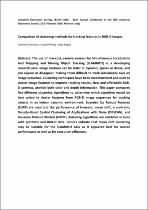JavaScript is disabled for your browser. Some features of this site may not work without it.
- ResearchSpace
- →
- Research Publications/Outputs
- →
- Conference Publications
- →
- View Item
| dc.contributor.author |
Pancham, Ardhisha

|
|
| dc.contributor.author |
Withey, Daniel J

|
|
| dc.contributor.author |
Bright, G

|
|
| dc.date.accessioned | 2017-06-07T06:04:06Z | |
| dc.date.available | 2017-06-07T06:04:06Z | |
| dc.date.issued | 2016-10 | |
| dc.identifier.citation | Pancham, A., Withye, D.J. and Bright, G. 2016. Comparison of clustering methods for tracking features in RGB-D images. Industrial Electronics Society, IECON 2016 - 42nd Annual Conference of the IEEE Industrial Electronics Society, 22-27 October 2016, Florence, Italy. DOI: 10.1109/IECON.2016.7793050 | en_US |
| dc.identifier.isbn | 978-1-5090-3474-1 | |
| dc.identifier.uri | DOI: 10.1109/IECON.2016.7793050 | |
| dc.identifier.uri | http://ieeexplore.ieee.org/abstract/document/7793050/ | |
| dc.identifier.uri | http://hdl.handle.net/10204/9108 | |
| dc.description | Copyright: 2016 IEEE. Due to copyright restrictions, the attached PDF file only contains the abstract of the full text item. For access to the full text item, please consult the publisher's website. | en_US |
| dc.description.abstract | The use of low-cost, camera sensors for Simultaneous Localization And Mapping and Moving Object Tracking (SLAMMOT) is a developing research area. Image features can be static or dynamic, sparse or dense, and can appear or disappear, making them difficult to track individually over an image sequence. Clustering techniques have been recommended and used to cluster image features to improve tracking results. New and affordable RGB-D cameras, provide both color and depth information. This paper compares five different clustering algorithms to determine which algorithm would be best suited to cluster features from RGB-D image sequences for tracking objects in an indoor dynamic environment. Speeded Up Robust Features (SURF) are used and the performance of k-means, mean shift, a contrario, Density-Based Spatial Clustering of Applications with Noise (DBSCAN), and Gaussian Mixture Models (GMM) clustering algorithms are validated in tests with synthetic and RGB-D data. Results indicate that mean shift clustering may be suitable for the SLAMMOT task as it appeared best for overall performance as well as for execution efficiency. | en_US |
| dc.language.iso | en | en_US |
| dc.publisher | IEEE | en_US |
| dc.relation.ispartofseries | Worklist;18126 | |
| dc.subject | Simultaneous Localization And Mapping and Moving Object Tracking | en_US |
| dc.subject | SLAMMOT | en_US |
| dc.subject | Clustering methods | en_US |
| dc.subject | RGB-D images | en_US |
| dc.title | Comparison of clustering methods for tracking features in RGB-D images | en_US |
| dc.type | Conference Presentation | en_US |
| dc.identifier.apacitation | Pancham, A., Withey, D. J., & Bright, G. (2016). Comparison of clustering methods for tracking features in RGB-D images. IEEE. http://hdl.handle.net/10204/9108 | en_ZA |
| dc.identifier.chicagocitation | Pancham, Ardhisha, Daniel J Withey, and G Bright. "Comparison of clustering methods for tracking features in RGB-D images." (2016): http://hdl.handle.net/10204/9108 | en_ZA |
| dc.identifier.vancouvercitation | Pancham A, Withey DJ, Bright G, Comparison of clustering methods for tracking features in RGB-D images; IEEE; 2016. http://hdl.handle.net/10204/9108 . | en_ZA |
| dc.identifier.ris | TY - Conference Presentation AU - Pancham, Ardhisha AU - Withey, Daniel J AU - Bright, G AB - The use of low-cost, camera sensors for Simultaneous Localization And Mapping and Moving Object Tracking (SLAMMOT) is a developing research area. Image features can be static or dynamic, sparse or dense, and can appear or disappear, making them difficult to track individually over an image sequence. Clustering techniques have been recommended and used to cluster image features to improve tracking results. New and affordable RGB-D cameras, provide both color and depth information. This paper compares five different clustering algorithms to determine which algorithm would be best suited to cluster features from RGB-D image sequences for tracking objects in an indoor dynamic environment. Speeded Up Robust Features (SURF) are used and the performance of k-means, mean shift, a contrario, Density-Based Spatial Clustering of Applications with Noise (DBSCAN), and Gaussian Mixture Models (GMM) clustering algorithms are validated in tests with synthetic and RGB-D data. Results indicate that mean shift clustering may be suitable for the SLAMMOT task as it appeared best for overall performance as well as for execution efficiency. DA - 2016-10 DB - ResearchSpace DP - CSIR KW - Simultaneous Localization And Mapping and Moving Object Tracking KW - SLAMMOT KW - Clustering methods KW - RGB-D images LK - https://researchspace.csir.co.za PY - 2016 SM - 978-1-5090-3474-1 T1 - Comparison of clustering methods for tracking features in RGB-D images TI - Comparison of clustering methods for tracking features in RGB-D images UR - http://hdl.handle.net/10204/9108 ER - | en_ZA |






